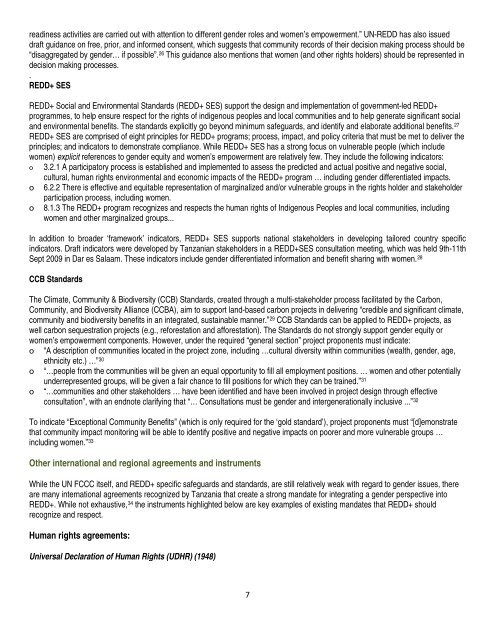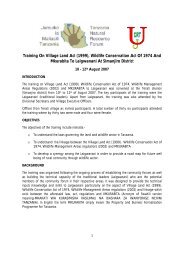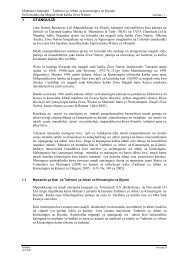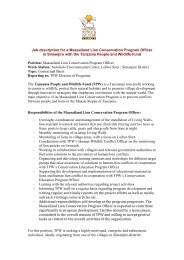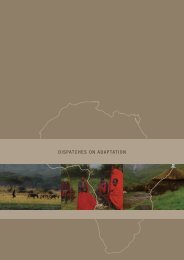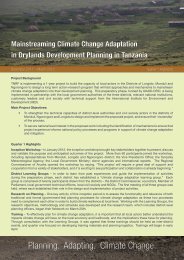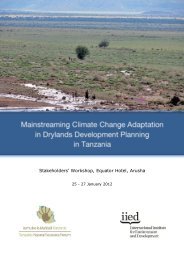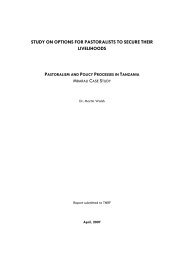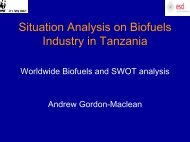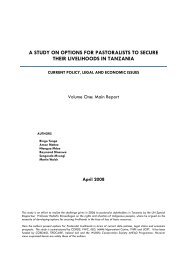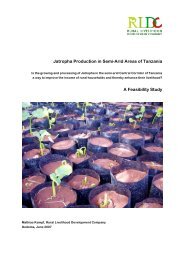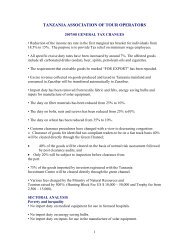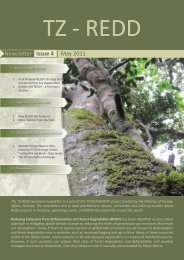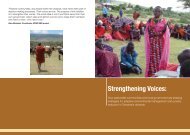Gender and REDD+ in Tanzania An overview of key issues
Gender and REDD+ in Tanzania: An overview of key issues
Gender and REDD+ in Tanzania: An overview of key issues
- No tags were found...
Create successful ePaper yourself
Turn your PDF publications into a flip-book with our unique Google optimized e-Paper software.
ead<strong>in</strong>ess activities are carried out with attention to different gender roles <strong>and</strong> women’s empowerment.” UN-REDD has also issued<br />
draft guidance on free, prior, <strong>and</strong> <strong>in</strong>formed consent, which suggests that community records <strong>of</strong> their decision mak<strong>in</strong>g process should be<br />
“disaggregated by gender… if possible”. 26 This guidance also mentions that women (<strong>and</strong> other rights holders) should be represented <strong>in</strong><br />
decision mak<strong>in</strong>g processes.<br />
.<br />
<strong>REDD+</strong> SES<br />
<strong>REDD+</strong> Social <strong>and</strong> Environmental St<strong>and</strong>ards (<strong>REDD+</strong> SES) support the design <strong>and</strong> implementation <strong>of</strong> government-led <strong>REDD+</strong><br />
programmes, to help ensure respect for the rights <strong>of</strong> <strong>in</strong>digenous peoples <strong>and</strong> local communities <strong>and</strong> to help generate significant social<br />
<strong>and</strong> environmental benefits. The st<strong>and</strong>ards explicitly go beyond m<strong>in</strong>imum safeguards, <strong>and</strong> identify <strong>and</strong> elaborate additional benefits. 27<br />
<strong>REDD+</strong> SES are comprised <strong>of</strong> eight pr<strong>in</strong>ciples for <strong>REDD+</strong> programs; process, impact, <strong>and</strong> policy criteria that must be met to deliver the<br />
pr<strong>in</strong>ciples; <strong>and</strong> <strong>in</strong>dicators to demonstrate compliance. While <strong>REDD+</strong> SES has a strong focus on vulnerable people (which <strong>in</strong>clude<br />
women) explicit references to gender equity <strong>and</strong> women’s empowerment are relatively few. They <strong>in</strong>clude the follow<strong>in</strong>g <strong>in</strong>dicators:<br />
o 3.2.1 A participatory process is established <strong>and</strong> implemented to assess the predicted <strong>and</strong> actual positive <strong>and</strong> negative social,<br />
cultural, human rights environmental <strong>and</strong> economic impacts <strong>of</strong> the <strong>REDD+</strong> program … <strong>in</strong>clud<strong>in</strong>g gender differentiated impacts.<br />
o 6.2.2 There is effective <strong>and</strong> equitable representation <strong>of</strong> marg<strong>in</strong>alized <strong>and</strong>/or vulnerable groups <strong>in</strong> the rights holder <strong>and</strong> stakeholder<br />
participation process, <strong>in</strong>clud<strong>in</strong>g women.<br />
o 8.1.3 The <strong>REDD+</strong> program recognizes <strong>and</strong> respects the human rights <strong>of</strong> Indigenous Peoples <strong>and</strong> local communities, <strong>in</strong>clud<strong>in</strong>g<br />
women <strong>and</strong> other marg<strong>in</strong>alized groups...<br />
In addition to broader ‘framework’ <strong>in</strong>dicators, <strong>REDD+</strong> SES supports national stakeholders <strong>in</strong> develop<strong>in</strong>g tailored country specific<br />
<strong>in</strong>dicators. Draft <strong>in</strong>dicators were developed by <strong>Tanzania</strong>n stakeholders <strong>in</strong> a <strong>REDD+</strong>SES consultation meet<strong>in</strong>g, which was held 9th-11th<br />
Sept 2009 <strong>in</strong> Dar es Salaam. These <strong>in</strong>dicators <strong>in</strong>clude gender differentiated <strong>in</strong>formation <strong>and</strong> benefit shar<strong>in</strong>g with women. 28<br />
CCB St<strong>and</strong>ards<br />
The Climate, Community & Biodiversity (CCB) St<strong>and</strong>ards, created through a multi-stakeholder process facilitated by the Carbon,<br />
Community, <strong>and</strong> Biodiversity Alliance (CCBA), aim to support l<strong>and</strong>-based carbon projects <strong>in</strong> deliver<strong>in</strong>g “credible <strong>and</strong> significant climate,<br />
community <strong>and</strong> biodiversity benefits <strong>in</strong> an <strong>in</strong>tegrated, susta<strong>in</strong>able manner.” 29 CCB St<strong>and</strong>ards can be applied to <strong>REDD+</strong> projects, as<br />
well carbon sequestration projects (e.g., reforestation <strong>and</strong> afforestation). The St<strong>and</strong>ards do not strongly support gender equity or<br />
women’s empowerment components. However, under the required “general section” project proponents must <strong>in</strong>dicate:<br />
o “A description <strong>of</strong> communities located <strong>in</strong> the project zone, <strong>in</strong>clud<strong>in</strong>g …cultural diversity with<strong>in</strong> communities (wealth, gender, age,<br />
ethnicity etc.) …”<br />
30<br />
o “…people from the communities will be given an equal opportunity to fill all employment positions. … women <strong>and</strong> other potentially<br />
underrepresented groups, will be given a fair chance to fill positions for which they can be tra<strong>in</strong>ed.” 31<br />
o “…communities <strong>and</strong> other stakeholders … have been identified <strong>and</strong> have been <strong>in</strong>volved <strong>in</strong> project design through effective<br />
consultation”, with an endnote clarify<strong>in</strong>g that “… Consultations must be gender <strong>and</strong> <strong>in</strong>tergenerationally <strong>in</strong>clusive ...” 32<br />
To <strong>in</strong>dicate “Exceptional Community Benefits” (which is only required for the ‘gold st<strong>and</strong>ard’), project proponents must “[d]emonstrate<br />
that community impact monitor<strong>in</strong>g will be able to identify positive <strong>and</strong> negative impacts on poorer <strong>and</strong> more vulnerable groups …<br />
<strong>in</strong>clud<strong>in</strong>g women.” 33<br />
Other <strong>in</strong>ternational <strong>and</strong> regional agreements <strong>and</strong> <strong>in</strong>struments<br />
While the UN FCCC itself, <strong>and</strong> <strong>REDD+</strong> specific safeguards <strong>and</strong> st<strong>and</strong>ards, are still relatively weak with regard to gender <strong>issues</strong>, there<br />
are many <strong>in</strong>ternational agreements recognized by <strong>Tanzania</strong> that create a strong m<strong>and</strong>ate for <strong>in</strong>tegrat<strong>in</strong>g a gender perspective <strong>in</strong>to<br />
<strong>REDD+</strong>. While not exhaustive, 34 the <strong>in</strong>struments highlighted below are <strong>key</strong> examples <strong>of</strong> exist<strong>in</strong>g m<strong>and</strong>ates that <strong>REDD+</strong> should<br />
recognize <strong>and</strong> respect.<br />
Human rights agreements:<br />
Universal Declaration <strong>of</strong> Human Rights (UDHR) (1948)<br />
7


